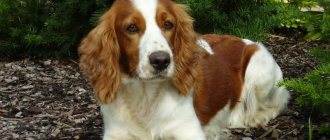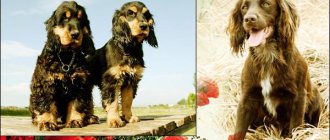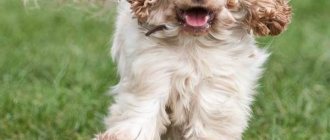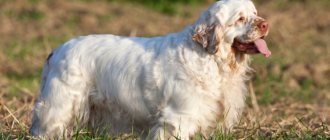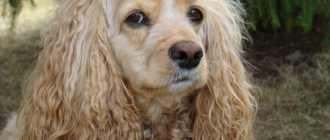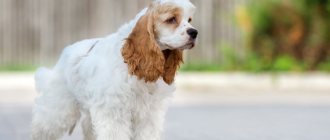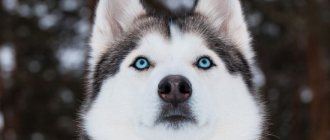The Russian Spaniel is a friendly, loyal and easy-going dog that loves hunting and other forms of physical activity.
It is vital for representatives of the breed to show their hunting talents. That is why it is important to walk dogs living in the city regularly and allow them to release their pent-up energy through games and exercise.
If these conditions are met, the Russian Spaniel will become an excellent friend and companion for any owner.
How to prepare to buy a puppy
Caring for a spaniel puppy is a troublesome task. This breed is active from birth. To prevent the new family member from causing trouble, you need to organize his own corner for him. It is better to place the dog bed in a warm, dry and clean corner, so that the puppy can see as much of the apartment as possible (observation of the kitchen is especially valuable), but not get underfoot. A small puppy needs a change of diapers.
Cocker spaniel dog
What else you need to think about in advance:
- remove from the puppy’s access area all objects that could injure him or damage them. It must be removed to a height of 80cm;
- space – pets love to run, they need a lot of space;
- bowls, leash, collar, toys, grooming tools;
- supply of disposable diapers. The puppy will not immediately learn to do his business outside.
As soon as possible after purchasing a puppy, you should take it to the veterinarian and get vaccinated.
How to choose?
The choice of a puppy should be approached with the utmost seriousness. In order to purchase a physically and mentally healthy animal, future owners turn to kennel clubs, breed forums, and nursery owners.
You should not choose a puppy based on the principle of the minimum price - this often means that the dogs and puppies are poorly raised, are not fed enough, do not have quality care and the necessary documents on origin.
The absence of a puppy card (birth certificate for puppies) should alert the potential owner - there is a danger of buying a non-pedigreed animal that will not look like a cocker spaniel with age.
When meeting puppies, you need to pay attention to the appearance of the mother and puppies - they should be cheerful, active and inquisitive, with shiny fur, clear eyes.
If the puppies are lethargic and hiding, it may be worth looking elsewhere.
Vaccination schedule
| Age | Nobivak vaccine | Eurikan vaccine |
| 7 weeks | Deworming | |
| 8-9 weeks (vaccination against plague, viral hepatitis, adenoviral infections, parvovirus enteritis, parainfluenza, leptospirosis) | DHPPiL | DHPPI2+L |
| 11 weeks | Deworming according to indications | |
| 12 weeks (vaccination against plague, viral hepatitis, adenoviral infections, parvovirus enteritis, parainfluenza, leptospirosis + rabies vaccination) | DHPPiL+R | DHPPI2+RL |
| 1 year | DHPPiL+RL | DHPPI2+RL |
| Vaccinations are then repeated annually at the same time. |
Vaccination and veterinary medicine
The first vaccination for spaniels is given at 9 weeks. A few days before this, the puppy is rid of worms. After 1-2 weeks, vaccinations are repeated. Only 10-14 days after the second stage, you can go for the first walk.
At 6-7 months, after a complete change of teeth, the Russian spaniel undergoes the third stage of vaccination. Be sure to have a rabies vaccination - this is one of the most important vaccinations for a hunting dog.
At 12 months, the third stage is repeated.
Then the entire vaccination course is carried out once a year.
It is better to choose a veterinarian before the first vaccination and do not change it throughout the dog’s life.
English Cocker Spaniel: puppy care
Jack Russell Terrier: care and maintenance at home
As soon as an English spaniel appears in the house, it needs to be taught hygiene procedures - cleaning its ears, bathing, cutting and combing its fur. But the most difficult part of caring for a spaniel puppy is training. The dog needs to be taught to obey commands and develop the habit of obeying its owner. Reward for good behavior works best - petting, praise, treats. To express dissatisfaction, it is enough to speak to the puppy in a disappointed tone; animals sense intonation very well.
Important! You cannot shout, swear, or hit the dog - the effect of training will be reduced. Interactions with other dogs, children, and strangers need to be controlled.
Cocker spaniel puppy
From puppy to adult dog
The period of active growth in Cocker Spaniel puppies usually ends by 10-11 months, but strengthening of muscles, ligaments and skeleton lasts up to 15-18 months.
Before this age, breeders recommend introducing vitamin complexes for growing animals into the dog’s diet.
The weight of an adult male cocker spaniel is 12-14 kg, height – 38-39 cm. Bitches weigh on average 10-12 kg, their height is 35-36 cm.
Price range
If a puppy’s exhibition and breeding career is planned, then the owners should expect a cost of 25-30 tr . If a puppy is purchased as a pet, the price varies from 8 to 20 thousand rubles.
A Cocker Spaniel will become your best friend, a companion in games, walks and travel, and will delight you for many years, provided it is properly maintained and well-educated.
What to feed?
The first three months of a Cocker Spaniel's life lay the foundation for a long, healthy and active life.
IMPORTANT!
It is important to feed your puppy complete and balanced food.
There are two ways to feed puppies and dogs - industrial ready-made food and homemade diets.
High-quality dry food saves time on preparation; it is balanced according to the age and size of the dog.
This can be food for medium breed puppies from: Royal Canin, Pro Plan, Hills, Purina ONE, Eukanuba, Monge, Brit Care, Pronature Original, Bosch, Acana, Now Fresh, Orijen, Grandorf, Go Natural holistic, Farmina N&D, Pronature Holistic.
The daily portion of food is indicated on the food packaging and is calculated based on the puppy’s weight. It is divided by the number of feedings and given out in equal shares. When feeding dry food, it is important to provide your puppy with clean water.
For a small puppy, feeding five times a day is optimal..
When feeding natural food, the owner is confident in the quality of the products and their origin. Meat, fish, cereals, dairy products, fruits, vegetables and herbs will help the puppy grow up healthy and vigorous.
At the age of up to 3 months, a cocker spaniel should eat approximately 6% of its body weight in food per day. With a weight of 3 kg, the daily portion of food is 180 – 200 g.
Of these, half are meat, 30% are cereals, 10% are vegetables and 10% are dairy products. The daily portion is divided by the number of feedings.
Sample menu for a 3 kg puppy for a week:
| Daily norm/5 feedings, gr. | Meat/fish, 100 grams per day. | Porridge, | Vegetables fruits | Dairy products | Additionally | |
| 1 | 200 | Beef | Rice | Apple, Carrot | Kefir | Boiled egg |
| 2 | 200 | Turkey | Buckwheat | Zucchini | Cottage cheese | Berries |
| 3 | 200 | Beef | Hercules | Cucumber | Unsweetened yogurt | Greenery |
| 4 | 200 | Lean sea fish without bones | Rice | Pear, Spinach | Kefir | Sea kale |
| 5 | 200 | Beef | Rice and buckwheat | Beet | Ryazhenka | Boiled egg |
| 6 | 200 | Lean pork | Hercules | Apple | Cottage cheese | Rosehip berries |
| 7 | 200 | Chicken | Buckwheat | Pumpkin | Cottage cheese | Banana |
Caring for teeth, nails and ears
American cocker and English cocker spaniel: differences
The ears of the American and English spaniel are the hallmark of the breed. Unfortunately, they often become inflamed. The ears should be inspected after each walk, and cleaned once a week with a cotton swab dipped in an antiseptic solution or a special lotion for dogs.
Nail trimming
On the street, the dog wears its claws off on asphalt and hard stones, so in the summer there is no need to trim its claws. For winter you need to buy a nail clipper. A dog manicure should be done once a month.
Taking care of your teeth
The natural way to clean teeth in dogs is mechanical cleaning by chewing solid food. For this function to be performed in pets, you need to give them chew toys. Once every 2-3 days the animal’s teeth are brushed. To do this, you need to get a dog brush and toothpaste that are convenient and safe for your pet.
Feeding
The English Cocker Spaniel, like the American Cocker, is unpretentious in food. He can eat anything. For a dog to live a long and fulfilling life, its diet must be balanced, taking into account activity.
Feeding the puppy
Feeding your Cocker Spaniel at a certain time and in a strictly designated place will help accustom him to routine and order.
Until the age of two months, the baby is fed six times a day. From two to four months, the number of feedings is four to five times. By six months, a grown puppy can be fed three to four times. By the age of ten months, the pet is transferred to two meals a day. And this regime remains constant.
Feeding an adult dog
There is an opinion among some breeders that an adult cocker can be fed once a day. It is worth disproving such a theory. It is better to divide the dog’s diet into two equal portions and feed it in the morning and evening, with an equal time interval. With this scheme, nutrients enter the body evenly.
Cockers are prone to gluttony. Appetite must be controlled.
Grooming
Beagle: care and maintenance in the apartment and in the house
The most difficult thing in caring for and maintaining a cocker spaniel is grooming its coat. This breed has a thick and soft coat, which perfectly protects it from frost and snow, but at home it causes inconvenience to its owners. Just like humans, cockers need to be brushed every day, and twice a day when shedding. For this you need to use a special comb for long-haired dogs. You should not brush your spaniel with a human comb or a cat brush.
Spaniels like water treatments
Pet bathing and care products
Spaniels love water and tolerate bathing easily. Rules for safe bathing procedures:
- wash your dog no more than twice a month - then the skin will not dry out;
- use shampoo for long-haired dogs;
- After bathing, dry the dog with a towel and dry it with a hairdryer;
- Until the wool is completely dry, avoid drafts.
Note! If the dog gets dirty, it can be bathed unscheduled. Some spaniels remember their hunting roots and enjoy swimming in open water.
Dog grooming and cutting
The fur on the chest, paws and tips of the ears needs to be trimmed. This is where this breed can develop mats even with proper brushing. You can learn all the manipulations yourself; this will require scissors and a lot of patience. If a dog has been accustomed to grooming since childhood, it will not interfere with hygiene procedures.
If owners want to send their pet to an exhibition, then they need to contact a professional groomer. The specialist knows how to care for a spaniel and will put its coat in perfect order so that all the advantages of the breed are visible.
What tools and equipment will be needed
A complete set of tools for grooming at home:
- table with adjustable height. For dogs, it replaces the grooming chair;
- clipper for cutting long-haired dogs with soft fur (parameters are adjustable);
- attachments for the machine (depending on the desired effect);
- hairdressing scissors – straight and thinning;
- wool brush;
- two combs - with frequent and sparse teeth.
Attention! If the dog does not like the procedure, you have to keep it on a leash. Then the haircut must be carried out by two people.
On the hunt
Tail docking
When the breed was first developed, tail docking was mandatory. It protected the dog from injury during the hunt. But now, when spaniels have become mainly decorative, such an operation is not necessary. Pets with undocked tails can participate in exhibitions.
If the owner nevertheless decides to undergo the procedure, then the most suitable age is up to 3 months. In older puppies, the likelihood of complications increases sharply. After surgery, the puppy needs to treat the wound with hydrogen peroxide and Levomikol every day until it heals. The procedure is performed only on healthy puppies.
Website about dogs
Cocker Spaniels are one of the most beloved and popular dog breeds in the world. Cute American and English cocker spaniels always attract attention at any exhibition. The variety of colors, characteristic “eared” appearance, cheerful and easy-going character of these dogs allowed them to win the hearts of thousands of dog owners around the world.
How difficult are spaniels to care for, and can this breed be recommended to novice dog breeders? We talk about the features of caring for cocker spaniels in this article.
Let's start with the most striking breed trait. Of course, these are the famous cocker spaniel ears. Long drooping ears give dogs of this breed an incredible resemblance to a soft toy. But do not forget that this is not only a funny detail of the exterior, but also a working organ responsible for the animal’s full auditory perception.
Dogs with long, drooping ears are more susceptible to various ear diseases. Spaniels often have otitis media, and they are more likely than other breeds to become victims of ear mites.
You shouldn’t be scared - this is just a tribute to the anatomical shape of the ear, tightly covering the entrance to the auricle. For a hunting dog (and all spaniels, including cockers, come from one ancestor - a tireless assistant on the hunt), such ears were a requirement. When working in the field and in reservoirs (they hunted waterfowl with spaniels), long ears protected the ear from possible ingress of water.
Nowadays decorative dogs do not have such a need, but the ears remain the signature highlight of the spaniel. And they require attention and special care. It should be understood that this form prevents ventilation of the ear, which leads to unpleasant consequences. If the owner of a husky or a German shepherd can look into the ears of their pet once a month, then the owners of spaniels need to do a preventive examination at least once every two weeks and clean their ears from plaque, if necessary.
You should definitely go to the vet if your dog constantly scratches his ear, shakes his head, or whines in pain.
Description of the breed
The English Cocker has a compact body that should fit all standards. The animal must weigh between 13.5 and 14.5 kilograms. The height of the male is from 39 to 41 cm, and the female is from 37 centimeters. The pet's fur can be golden, red, snow-white, or black. There may be mixed colors, and the coat feels silky.
The dog's fur is not curly and curls a little. It can be straight, but there is a good undercoat. If the coat is curly or fluffy, then it does not meet the standards.
A dog of this breed looks like this. The dog has a squat and muscular body. The animal has a flat skull and an expressive muzzle. The eyes are smart and you can immediately see from them that the pet has developed intelligence. They can be used to determine the animal's mood well. If the eyes are shining, then the pet is cheerful and cheerful.
A sad dog's eyes lose their sparkle. The dog has the correct bite and a strong neck. The animal has strong paws, they are covered with a lot of hair. The dog has long and wide ears. They must be at the same level as the eyes.
Such animals walk gracefully and move smoothly, it seems as if they do not touch the ground with their limbs. The English Cocker is most often used as a companion. Security qualities will appear in an animal only after a certain course of training.
Character
The English Cocker has good intelligence and kindness. Such animals are considered sociable and loyal. The pet prefers to spend more time with its owner. He is friends with the child and will never harm him.
There are the following character traits:
- The animal is energetic and has difficulty sitting still. If the pet does not express its mobility, then the house will be upside down.
- Can't cope with loneliness. If you leave your pet alone in the apartment, it can begin to damage furniture and shoes.
- He loves to chase birds, because such dogs have a well-developed hunting instinct. The owner will not be able to influence the behavior of the pet.
- The animal loves to sleep next to its owner or in a chair. These breeds do not like drafts and often catch colds.
- The English Cocker is very energetic and will need to be walked for at least two hours every day.
- The dog loves to swim in various bodies of water; for this breed, swimming is the best training.
- This breed is friendly to all pets. It will be easy to get along with dogs or cats.
- The dog barks on rare occasions. The dog can give voice when hunting for prey.
- The pet does not have protective qualities.
- Does not approach strangers, but can quickly make friends and begin to trust. He can rarely bite; if he doesn’t like something, he shows it by growling.
- This breed requires certain physical activities.
- The dog can see even a slight change in the owner's mood.
English Cocker Spaniels can be jealous, but they are incapable of being offended. If a dog is punished, it will forget about it in fifteen minutes. This breed always has an excellent appetite and does not go overboard with its food. Pets constantly love to beg, so you need to monitor this so that excess weight does not occur.
Animals love their owner and obey him. Some spaniels can bark for a long time, this is the only negative in the breed. The pet itself is a sports dog. They have excellent eyesight and sense of smell.
Cocker diet
Cocker spaniels are suitable for premium dry food. This way the owners will be sure that the food is of high quality. You can feed your dog natural products, then the basis of the diet should be boiled boneless meat. For variety, you can add offal (boiled), fermented milk products, and soft-boiled eggs. Once a week, bread, cereals, boiled vegetables, and sometimes dried fruits and crackers may appear on the menu.
An adult dog is fed once or twice a day, puppies - from 6 to 3 depending on age. The amount of food should correspond to the physical activity of the pet. The active nature of cockers requires a lot of energy, especially in young dogs. Owners should be prepared for their pet's gluttony.
Accustoming to cleanliness
You need to start training from the first days the puppy is at home. If your cocker spaniel has not yet been vaccinated, you need to teach him to go to the toilet in a diaper. To do this, several diapers are placed where the puppy sleeps, eats and plays, and other areas are isolated.
At 1.5 months, the cocker defecates approximately 5 times a day - after eating, sleeping, playing - the puppy’s behavior changes sharply, he sniffs restlessly, and at this moment carefully bring him to the diaper.
After he goes to the toilet in his place, be sure to praise him and give him a treat - this way you will reinforce his correct behavior and speed up the training process.
A fully vaccinated puppy can be taken outside two weeks after the second comprehensive vaccination. As soon as the puppy begins to restlessly look for a place to rest, you need to take him outside.
If by this moment the puppy is already wearing a diaper, you just need to take the diaper with you outside and lay it in the place where the puppy needs to go to the toilet.
Usually, toilet training takes 1 month, but due to their age, puppies can make mistakes up to 5-6 months.
Food allergies
Spaniels are great lovers of tasty food, which often manifests itself in excess weight and allergic manifestations. If you notice an abundance of dandruff, itching and scratching, perhaps it is not a new shampoo, but that your dog has an allergic reaction to a particular food product.
An important nuance: in dogs, food allergies are cumulative, that is, a dog can eat an allergen product for several months, and only later will it develop an allergy.
This makes it somewhat difficult to identify such a product and makes the recovery process slow. But you can still find such a product by eliminating potential threats from your dog’s diet one by one. First of all, you should pay attention to cereals (wheat, buckwheat, oatmeal) and chicken from the store. These products top the ranking of dog allergens.
In order not to guess, you can immediately switch your dog to dry hypoallergenic food - such food is available in the line of almost any brand.
From the love of food comes another threat to the health and even life of any cocker spaniel - overweight and obesity.
Excess weight in dogs is not only cute fat sides and a funny gait, it is also a fat-filled heart, liver, overloaded joints, ligaments, and spine.
Obesity is deadly for dogs. Therefore, if your pet begins to gain weight, this is not a reason to be touched - it urgently needs to be shown to a veterinarian. Most likely, if there are no pathologies, the problem is the excessive caloric content of food or its excessive quantity.
Adjust the dog’s diet, switch to lighter food (in ready-made dry and food you can choose food for sedentary dogs), cut down the portion, provide the dog with a sufficient level of physical activity.
These are the main points that every loving cocker spaniel owner should pay attention to. With proper care, these dogs live a long time.
Walks and games
If the owners liked the cocker spaniel, caring for it should definitely include walks. Such a dog needs to go outside not only for toilet chores - the pet needs physical activity. It is best to walk on training grounds where the dog can run without a leash. You need to walk your dog twice a day, for each walk for at least half an hour, but preferably an hour. If your pet doesn't run around enough during a walk, it will show its activity at home.
Ready for a walk
Health Features
This breed, like all hunters, is prone to some diseases and infections.
Possible diseases
- Otitis
- Obesity
- Allergy to certain foods
- Mycosis
- Leptospirosis
- Toxo- and piroplasmosis
- Intestinal parasitosis
- Blocked anal glands
- Pyometra.
Preventive measures against these diseases are regular veterinarian examinations and timely vaccination.
What diseases can occur in pets?
Each description of the breed emphasizes that cocker spaniels are distinguished by excellent health and great physical activity. But this breed has several weak points - ears, eyes, tail and hip joint. In addition, due to high activity, the dog can be injured. If the animal does not receive enough physical activity, there is a risk of obesity. Proper care and education helps reduce the risk of disease. It is advisable to undergo regular checkups with a veterinarian.
The Cocker Spaniel is a companion for hunting, outdoor activities and city life. The dog does not like to be bored, but it is very obedient and, with proper training, gets along well with children and does not show aggression towards other animals.
Diseases
When an animal is properly cared for, it rarely gets sick, but even if all the rules of keeping are followed, health problems may arise.
Common diseases:
- otitis;
- distichiasis;
- discopathy;
- cherry eye;
- entropion;
- hypothyroidism;
- keratoconjunctivitis;
- urolithiasis disease;
- atopy;
- cataract;
- glaucoma;
- lipoma;
- melanoma;
- hepatitis.
In addition, dogs can suffer from demodicosis, deafness, dwarfism, and skin cancer.
Relationships with children
For children under 3 years old, the dog can be dangerous because of his activity, but with older children he gets along well and can devote all his free time to them from his toys, which children should never interfere with.
However, children still need to be warned that this is a dog that still has poor control of its strength. In life, puppies bite each other and learn to hunt. While in the owner's house, the puppy will perceive children as his brothers and sisters, and therefore he will play with them accordingly.
Field Spaniel - an example of nobility
Content
The Field Spaniel is a small, harmoniously built dog with long, well-furred ears and dark almond-shaped eyes, looking seriously from under slightly raised eyebrows.
It was bred to retrieve game in hard-to-reach places and is capable of performing the work of retrievers. Let's find out what a field spaniel is and what the specifics of keeping the breed are.
Training Basics
Cocker spaniels actively accept training, but for this you need to follow the following rules:
- Timeliness. Start teaching your dog commands from an early age, otherwise it will be more difficult later.
- Regularity. Work with your pet daily, otherwise he will forget the learned commands.
- Sufficient load. Cockers are hunting dogs, so develop their potential. Use more active commands in training.
- Tolerance. Don't scold your spaniel for mistakes in training. The animal does not understand your speech; it needs time to get used to it.
- Game format. Get your pet interested and training will go smoothly.
- Personal contact. If you consider yourself the owner of a cocker, do the training yourself, without entrusting it to other family members or trainers.
First, train your spaniel to respond to your name, thereby attracting his attention. Then teach the command “place”, then “sit”, “to me” and “lie”. An important stage of training is learning the word “no” or its alternative “fu”. They are needed so that your apartment does not look like a battlefield.
Breeding
To be bred, a dog must meet all breeding stock requirements. A pair is selected only after passing operational tests and assessing the exterior.
There are breeders' clubs in every major city in Russia. Strict selection allows you to preserve and even improve the breed.
A Russian Spaniel will not be admitted to exhibitions if it has:
- problems with bite, teeth, lack thereof;
- different eye colors;
- aggression or cowardice;
- bobtail;
- weakly expressed differences by gender;
- absence of one or both testicles, their defects.
A deviation in height of 2 cm is considered a defect.
Russian spaniel is the pride of domestic dog handlers
The Russian Spaniel is a gun hunting breed of dog. Its selection began at the dawn of the 20th century, when English cocker and springer spaniels were brought to Russia. The characteristic type of the breed was determined after the Great Patriotic War. And in 1951, the first standard of the Russian spaniel was adopted, which met the requirements of hunters in the USSR.
